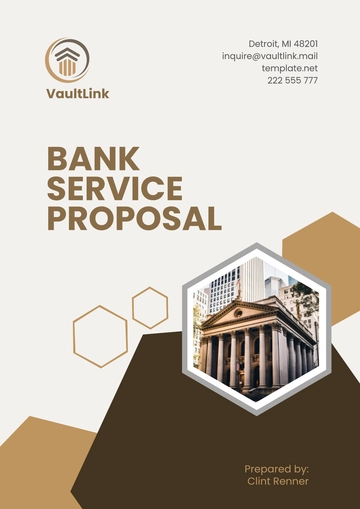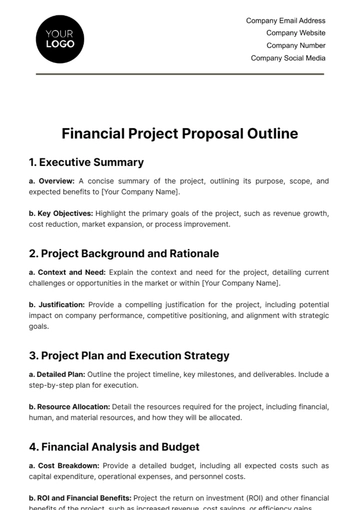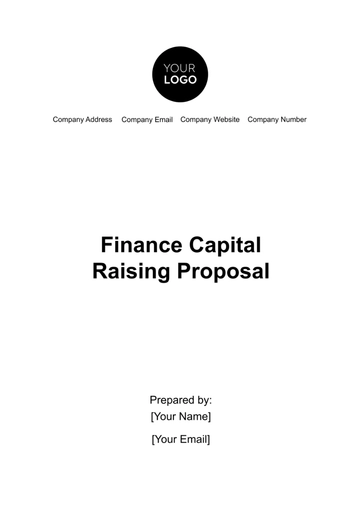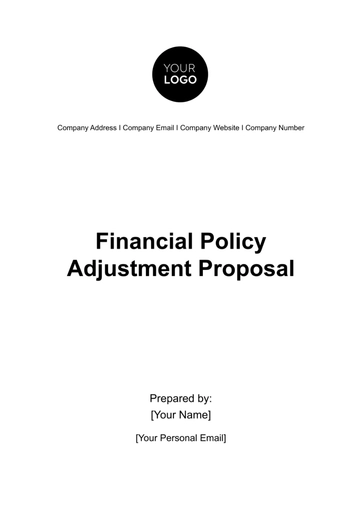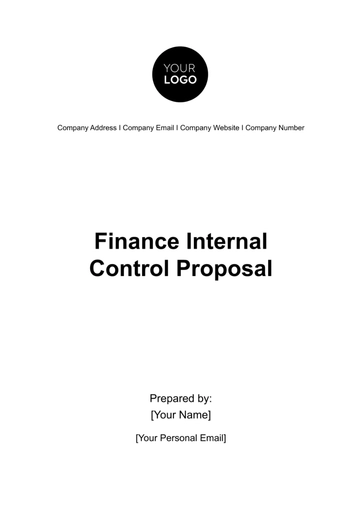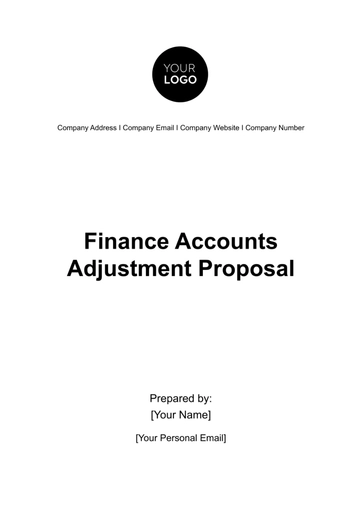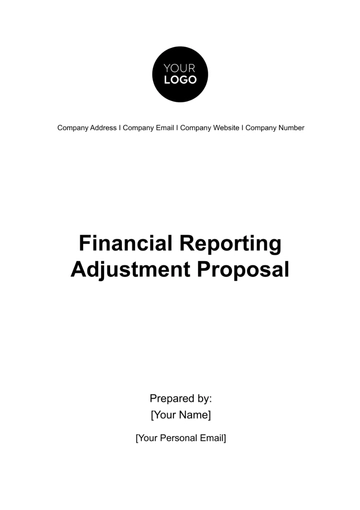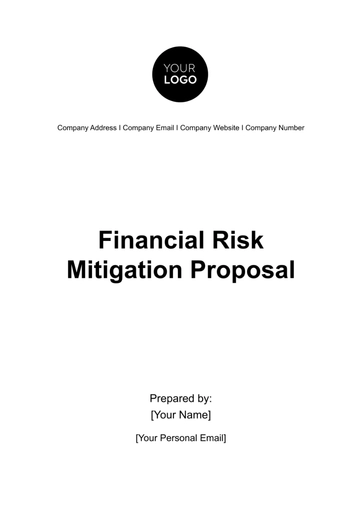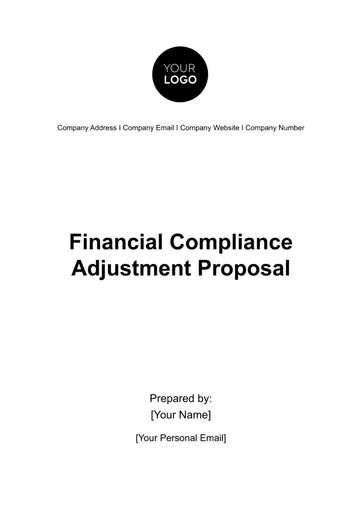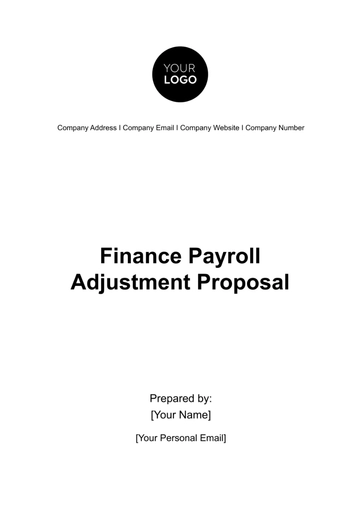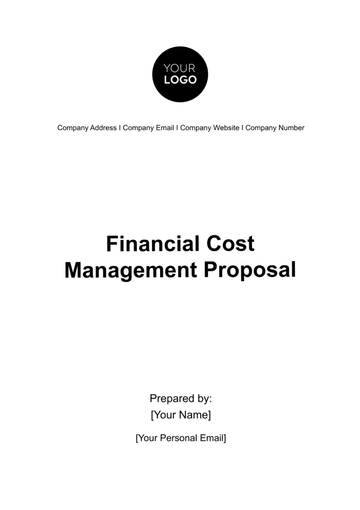Free Financial Risk Mitigation Proposal
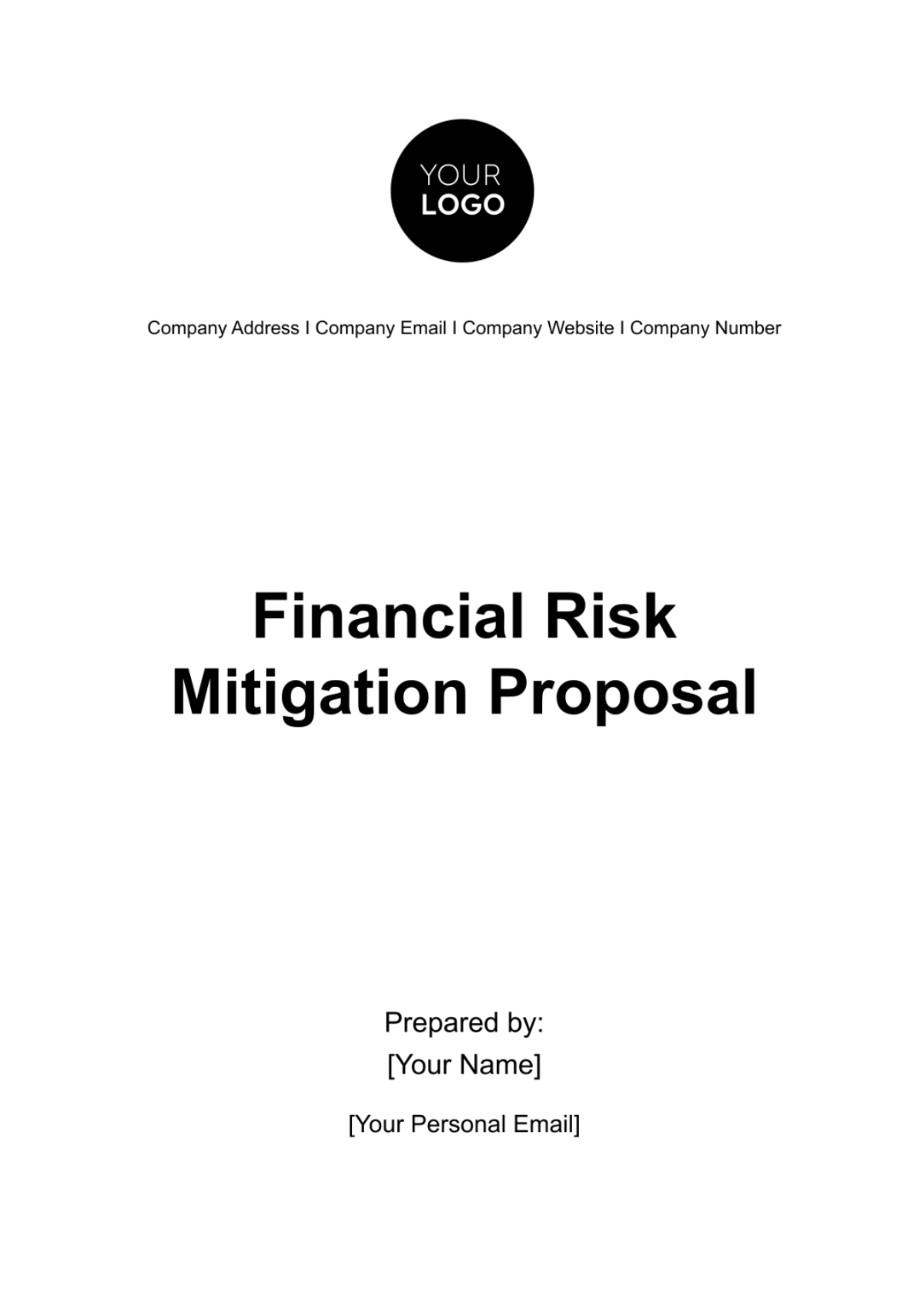
Executive Summary
This Financial Risk Mitigation Proposal presents a comprehensive approach to managing the key financial risks facing our organization. The primary objective of this proposal is to enhance our existing risk management framework to effectively address the challenges and uncertainties in the financial landscape, specifically focusing on market, credit, and operational risks.
Overview of the Proposal
The proposal begins with a detailed risk assessment, identifying the specific financial risks and evaluating their likelihood and potential impact. This assessment forms the basis for the development of our proposed mitigation strategies.
Summary of Objectives
Minimize exposure to market volatility and enhance our adaptability to market changes.
Reduce the risk of credit defaults and improve our credit management processes.
Strengthen our operational resilience against system failures and human errors.
Proposed Strategies
Dynamic Market Adaptation Strategy: To increase market responsiveness and adapt to changing consumer preferences and technological advancements.
Advanced Credit Risk Management System: Implementing predictive analytics for a more comprehensive evaluation of credit risks.
Enhanced Operational Risk Controls: Upgrading our IT infrastructure and intensifying staff training to mitigate operational risks.
Expected Outcomes
Improved market share and customer satisfaction through our dynamic market adaptation.
A significant reduction in credit defaults and more stable cash flows.
Enhanced operational efficiency and security, leading to reduced system downtime and data breaches.
Introduction
In the rapidly evolving economic landscape, our organization continuously strives to identify and manage financial risks effectively. This Financial Risk Mitigation Proposal is developed in response to the growing complexities and uncertainties in the financial environment that directly impact our operations and strategic goals.
Our organization, being at the forefront of technological innovations in the software industry, primarily faces financial risks associated with market volatility, credit exposure, and operational challenges. These risks, if not mitigated efficiently, could potentially hinder our growth trajectory and affect our financial stability.
Market Risk: We are exposed to market risks due to fluctuating demand for technology products and services. This volatility can significantly impact our revenue streams and market position.
Credit Risk: As we extend credit to our clients, there is a risk of default which could affect our cash flow and profitability.
Operational Risk: Being heavily reliant on sophisticated technology and human expertise, operational risks such as system failures or human errors could lead to financial losses.
Addressing these risks is imperative for sustaining our competitive advantage and ensuring long-term financial health. The upcoming sections of this proposal outline our comprehensive strategy to mitigate these identified financial risks effectively.
Risk Assessment
This section provides a thorough assessment of the financial risks facing our organization. By evaluating the likelihood and potential impact of these risks, we can formulate more targeted and effective mitigation strategies.
Risk | Description | Likelihood | Impact |
Market Risk | Volatility in the software market due to technological changes and consumer preferences. | Moderate | High |
Credit Risk | Risk of financial loss due to clients defaulting on credit payments. | Low | Medium |
Operational Risk | Potential for system failures, data breaches, or human errors impacting business operations. | Low | High |
Market Risk: The software industry is subject to rapid changes in technology and shifts in customer needs, making market risk a constant concern. The likelihood is moderate due to our diversified product portfolio, but the impact could be high if a significant market shift occurs without adequate preparation.
Credit Risk: Given our stringent credit vetting processes and diversified client base, the likelihood of significant credit defaults is low. However, any defaults that do occur could have a medium impact on our cash flow and revenue projections.
Operational Risk: The likelihood of operational risks, including system failures or data breaches, is low due to our robust security protocols and system redundancies. However, the impact of such an event would be high, potentially leading to financial losses and damage to our reputation.
Current Risk Management Strategies
In this section, we evaluate the effectiveness of our existing risk management measures. These strategies have been instrumental in navigating financial risks to date, and understanding their current efficacy will guide us in enhancing our risk mitigation approaches.
Risk | Current Strategy | Effectiveness Score (1-10) | Description |
Market Risk | Diversification of product portfolio and regular market analysis | 7 | Our diversified product range and continuous market analysis have been effective in mitigating market risk to a significant extent, though there is room for improvement in rapid response to market shifts. |
Credit Risk | Stringent credit assessment and monitoring | 8 | The strict credit vetting process and ongoing monitoring of credit accounts have effectively minimized defaults, but a more proactive approach in changing market conditions could enhance this strategy. |
Operational Risk | Robust IT security protocols and regular staff training | 6 | While our IT security and staff training protocols have been reasonably effective in reducing operational risks, recent technological advancements necessitate an update and enhancement of these measures. |
Proposed Risk Mitigation Strategies
Building on our assessment of the current risk management strategies, this section outlines enhanced measures to mitigate identified financial risks more effectively. These proposed strategies are designed to address the gaps and reinforce our risk management framework.
Dynamic Market Adaptation Strategy
To mitigate market risk, we propose a dynamic market adaptation strategy, involving real-time market analytics and agile product development processes. This approach includes establishing a dedicated market research team to continuously monitor market trends and customer feedback, enabling rapid adaptation of our product offerings. Additionally, integrating flexible design principles in our software development will allow us to respond swiftly to changing market demands.
Advanced Credit Risk Management System
To further reduce credit risk, we will implement an advanced credit risk management system that uses predictive analytics to assess client creditworthiness. This system will incorporate both historical financial data and predictive indicators like market trends and economic forecasts to evaluate credit risk more comprehensively. Regular reviews and updates to our credit policies based on these analytics will ensure ongoing effectiveness in a changing economic landscape.
Enhanced Operational Risk Controls
Addressing operational risks will involve upgrading our IT infrastructure with the latest cybersecurity technologies and enhancing staff training programs. We plan to invest in advanced cybersecurity tools, including AI-driven threat detection systems, and conduct regular cybersecurity drills and audits. Furthermore, we will implement a continuous learning program for our staff, focusing on the latest operational best practices and technological advancements, to minimize human error and system failures.
These proposed strategies are intended to bolster our risk mitigation capabilities, ensuring that our organization is well-prepared to handle potential financial risks and maintain our growth trajectory. The next sections will detail the implementation plan and monitoring measures for these strategies.
Implementation Plan
To effectively execute the proposed risk mitigation strategies, a structured implementation plan is crucial. This plan outlines the specific steps, timelines, and responsibilities to ensure that the strategies are put into action efficiently and effectively.
Step | Month | Responsibilities |
Establish Market Research Team | Months 1-2 | HR to recruit; Marketing to define roles and objectives |
Develop Real-Time Market Analytics System | Months 3-6 | IT to develop and integrate system; Marketing to provide input on analytics requirements |
Review and Update Product Development Processes | Months 7-8 | Product Development to incorporate agile methodologies; IT to provide technical support |
Implement Advanced Credit Risk Management System | Months 9-12 | Finance to oversee integration; IT to implement system infrastructure |
Update Credit Policies Based on Predictive Analytics | Month 13 | Finance to revise policies; Legal to ensure compliance |
Upgrade IT Infrastructure for Cybersecurity | Months 14-16 | IT to install new security tools; External cybersecurity experts to consult |
Conduct Cybersecurity Drills and Audits | Months 17-18 | IT to coordinate drills; External auditors to conduct audits |
Launch Continuous Learning Program for Staff | Month 19 | HR to develop program; All departments to participate |
Cost-Benefit Analysis
An essential aspect of implementing the proposed risk mitigation strategies is understanding their financial implications through a cost-benefit analysis. This analysis will help us weigh the costs of implementation against the potential benefits, ensuring a financially sound decision-making process.
Strategy | Estimated Cost | Expected Benefit |
Dynamic Market Adaptation Strategy | $100,000 | Increased market responsiveness, higher customer satisfaction, potential revenue growth by 10% |
Advanced Credit Risk Management System | $150,000 | Reduced credit defaults by 30%, improved cash flow stability |
Enhanced Operational Risk Controls | $200,000 | Decrease in system downtime by 50%, reduction in data breach incidents, improved operational efficiency |
Dynamic Market Adaptation Strategy: The cost of $100,000 includes team recruitment, development of analytics systems, and process updates. The expected benefits, such as a more responsive product offering and improved customer satisfaction, could lead to an estimated 10% revenue growth, which significantly outweighs the initial investment.
Advanced Credit Risk Management System: The investment of $150,000 is projected to reduce credit defaults by 30%, thereby improving our financial stability and cash flow. The enhanced system would also provide a more proactive approach to credit risk management, potentially saving costs related to bad debts.
Enhanced Operational Risk Controls: With an investment of $200,000, we anticipate a 50% decrease in system downtime and a significant reduction in data breach incidents. This strategy not only aims to reduce direct financial losses but also to maintain our reputation and client trust, which are invaluable.
Monitoring and Reporting
To ensure the effectiveness of the implemented risk mitigation strategies, a comprehensive monitoring and reporting framework is vital. This framework will enable us to track progress, measure success, and make informed adjustments as needed.
Strategy | KPIs | Targets |
Dynamic Market Adaptation Strategy | Market Share Growth; Customer Satisfaction Scores | Increase market share by 5% annually; Achieve 90% customer satisfaction |
Advanced Credit Risk Management System | Reduction in Credit Defaults; Improvement in Credit Recovery Rates | Decrease credit defaults by 30%; Increase credit recovery rates by 20% |
Enhanced Operational Risk Controls | Decrease in System Downtime; Reduction in Data Breach Incidents | Reduce system downtime by 50%; Achieve zero data breaches annually |
Regular reporting on these KPIs will be conducted quarterly to assess the effectiveness of each strategy and facilitate timely adjustments. This monitoring and reporting mechanism is designed to ensure that our risk mitigation efforts are aligned with our overall risk management objectives and organizational goals.
Review and Adjustment Process
In order to maintain the relevance and effectiveness of our risk mitigation plan, it is essential to have a structured process for regular review and adjustment. This process will ensure that the plan remains dynamic and adaptable to changing circumstances and new information.
The review and adjustment process will be a continuous cycle, involving the following steps:
Quarterly Reviews: Every three months, a comprehensive review of the risk mitigation strategies will be conducted. This will include assessing the progress against the set KPIs and evaluating the overall effectiveness of each strategy.
Stakeholder Feedback: Input from key stakeholders, including department heads and external partners, will be solicited during the review process. This feedback is crucial for gaining different perspectives on the effectiveness of the strategies and understanding any new risks or challenges.
Market and Regulatory Updates: The review process will also incorporate the latest market trends and regulatory changes. This ensures that our strategies are aligned with the current market environment and comply with all legal requirements.
Adjustment and Implementation: Based on the findings from the reviews, necessary adjustments to the strategies will be identified and implemented. This may include scaling up successful strategies, modifying underperforming ones, or introducing new measures in response to emerging risks.
Documentation and Communication: All changes and updates to the risk mitigation plan will be thoroughly documented and communicated across the organization to ensure alignment and clarity.
Annual Strategic Review: In addition to the quarterly reviews, an annual strategic review will be conducted to align the risk mitigation plan with the organization’s long-term strategy and objectives.
This iterative process ensures that our risk mitigation plan is not static but evolves in response to internal and external changes, maintaining its effectiveness and relevance.
Conclusion
In conclusion, this Financial Risk Mitigation Proposal outlines a comprehensive approach to identifying, assessing, and mitigating financial risks in our organization. Through detailed analysis, we have developed targeted strategies to address market, credit, and operational risks. The implementation of these strategies, along with a robust monitoring and reporting framework, positions us to manage these risks proactively.
The proposed review and adjustment process ensures that our risk mitigation efforts remain effective and adaptable to changing environments. As we move forward, the commitment to continuously improving our risk management practices is paramount to safeguarding our financial stability and supporting our long-term strategic objectives. This proposal is not only a blueprint for risk mitigation but also a testament to our proactive and forward-thinking approach to financial risk management.
- 100% Customizable, free editor
- Access 1 Million+ Templates, photo’s & graphics
- Download or share as a template
- Click and replace photos, graphics, text, backgrounds
- Resize, crop, AI write & more
- Access advanced editor
Delve into effective risk management with the Financial Risk Mitigation Proposal Template from Template.net. Editable and customizable in our AI Editor tool, this template offers a structured approach for proposing strategies to mitigate financial risks. Ideal for finance professionals, it aids in developing detailed proposals, ensuring robust risk management and safeguarding against potential financial challenges.
You may also like
- Business Proposal
- Research Proposal
- Proposal Request
- Project Proposal
- Grant Proposal
- Photography Proposal
- Job Proposal
- Budget Proposal
- Marketing Proposal
- Branding Proposal
- Advertising Proposal
- Sales Proposal
- Startup Proposal
- Event Proposal
- Creative Proposal
- Restaurant Proposal
- Blank Proposal
- One Page Proposal
- Proposal Report
- IT Proposal
- Non Profit Proposal
- Training Proposal
- Construction Proposal
- School Proposal
- Cleaning Proposal
- Contract Proposal
- HR Proposal
- Travel Agency Proposal
- Small Business Proposal
- Investment Proposal
- Bid Proposal
- Retail Business Proposal
- Sponsorship Proposal
- Academic Proposal
- Partnership Proposal
- Work Proposal
- Agency Proposal
- University Proposal
- Accounting Proposal
- Real Estate Proposal
- Hotel Proposal
- Product Proposal
- Advertising Agency Proposal
- Development Proposal
- Loan Proposal
- Website Proposal
- Nursing Home Proposal
- Financial Proposal
- Salon Proposal
- Freelancer Proposal
- Funding Proposal
- Work from Home Proposal
- Company Proposal
- Consulting Proposal
- Educational Proposal
- Construction Bid Proposal
- Interior Design Proposal
- New Product Proposal
- Sports Proposal
- Corporate Proposal
- Food Proposal
- Property Proposal
- Maintenance Proposal
- Purchase Proposal
- Rental Proposal
- Recruitment Proposal
- Social Media Proposal
- Travel Proposal
- Trip Proposal
- Software Proposal
- Conference Proposal
- Graphic Design Proposal
- Law Firm Proposal
- Medical Proposal
- Music Proposal
- Pricing Proposal
- SEO Proposal
- Strategy Proposal
- Technical Proposal
- Coaching Proposal
- Ecommerce Proposal
- Fundraising Proposal
- Landscaping Proposal
- Charity Proposal
- Contractor Proposal
- Exhibition Proposal
- Art Proposal
- Mobile Proposal
- Equipment Proposal
- Student Proposal
- Engineering Proposal
- Business Proposal

